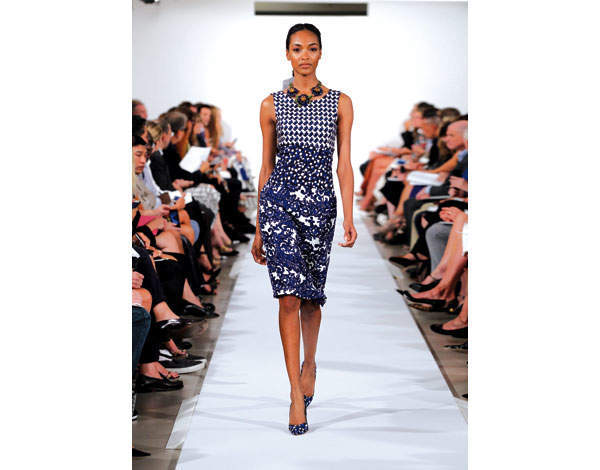

OSCAR BRAVO
‘I was born in the Dominican Republic. If my father had known I wanted to be a fashion designer he would have killed me,’ says Oscar de la Renta, sitting in his New York office, a corner room with large windows which make it look like a glass box. His desk is small and from here he can control what is going on in the atelier, the creative part of his job, the one he likes the most.
‘I was the only boy with six sisters. I started with architecture and then went to art school, and at eighteen I went to study in Spain. For my parents, Paris, where I wanted to go, was considered Sodome et Gomorrhe.’
His entry into fashion was a happy accident: ‘I wanted to be a painter, I was drawing well and fashion came by chance… Sometimes, to make money, I drew fashion illustrations. Through a friend I got an administrative job at Balenciaga in Madrid.’
Lanvin in Paris followed, then New York, where he established a career designing clothes which caused Vogue to say of him: ‘Nobody makes a woman feel more like a woman at night.’ Which seems a pretty high compliment.
As usual he is impeccably dressed, a beige bespoke gabardine suit made by his Madrid tailor (he started with the father, then the son and the nephew), Lopez Herbon y Cia. ‘All my shirts are made in Hong Kong by Mihi [which became Winston]. I had the shirtmaker recommended to me by Cary Grant, an unbelievably well dressed man. I never wear cufflinks; they are a bore and a waste of time.’
His shoes are hand-made by Lobb in Paris: brown during the day and black at night. Some pairs are 40 years old, which is an advertisement for investing in your accessories. On his lapel he is wearing the red rosette of the Légion d’Honneur on a little white ribbon, signifying France’s highest honour.
Smiling, de la Renta says he received it not for his career, but for being life senator of the Dominican Republic; President Chirac presented it to him. He wears it even if his friend, the French novelist Jean d’Ormesson, a permanent member of the French Academy, says about decorations: ‘You do not ask for them, you do not refuse them and you never wear them.’
Ready and able
‘I came to New York in the early Sixties. I knew that the future was ready-to-wear. The editor of French Vogue at the time was the writer Edmonde Charles-Roux, and she introduced me to Elizabeth Arden. I was advised by Diana Vreeland (editor of US Vogue) to create a collection of haute couture for Arden. I made a name for myself.’ And how: journalist Alice Hughes called him ‘a comet on the American style scene’, while society hostess CZ Guest said: ‘Oscar doesn’t even understand what bad taste is.’ (Quotes from Voguepedia.)
After three years de la Renta tried to convince Arden to go into the ready-to-wear business, but she did not follow him. So in the mid-Sixties he started his own company and, as he says, ‘I am still here after 50 years.’ He considers himself as a ‘good swimmer’ in business terms, but for him the most important thing is to understand the woman you’re dressing and then half the work is done.

Rather than some designers, who expose and exploit those who wear their clothes (or the barely there strips of fabric which pass for clothes), women feel secure and beautiful in his clothes. They are modest but don’t lack flair.
If you look at some of his dresses which have been worn to the Academy Awards in recent years, you notice flattering shapes, emphasising elegance and femininity. They are thoughtful not just in cut but in detail too, and seem to stem from his cultural alchemy: a Spanish upbringing, time in the ateliers of Paris and long exposure to the demure taste of New York society.
<p>FIRST LADIES
His position since the launch of his label in 1965 has been largely unquestioned, uncontroversial. He has been president of the Council of Fashion Designers of America twice (one can only imagine what their AGM is like) and has dressed three First Ladies.
When we meet, de la Renta is just back from Little Rock, Arkansas, where Hillary Clinton (one of his best friends) organised the first retrospective of his work at the Clinton Library. He recalls that in 1993 he went to a party at the White House with his wife Annette. He saw Hillary, then First Lady, and asked her: ‘Is that my dress?’ Luckily, it was. Oscar suggested to his friend Anna Wintour, editor of Vogue, that she put Clinton on the cover — a first for a First Lady.
De la Renta also made dresses for Nancy Reagan and Laura Bush, showing fashion for him has no political colour, although he is clear how he’d vote: ‘We spend Christmas every year with the Clintons and I am very fond of them, and I really hope Hillary will be our next president.’
His expansion continues tirelessly: he is proud of his new Mount Street store in London which carries every line of the brand, like the Madison Avenue store in New York: clothes for day and evening, jewellery, home, children’s wear, perfumes, bridalwear.
Oscar is convinced that 50 years on he has much more knowledge and experience than when he first arrived in New York, though he still describes himself as a ‘control freak’ and is constantly using his iPad to receive all the drawings and the models that his designers make. ‘I hate the word “retiring”,’ he says, adding that for him, going to his office is like a young boy entering a candy store.
The biggest battle
His recent energy is not so much perpetual enthusiasm as regained joie de vivre. De la Renta had lymphoma but is now totally cured. He is very open about it, so I ask him if he was frightened. ‘It was not as hard as I thought. I am lucky I had no side effects. There are two realities — we are born and we have to accept that we will die. When you have this kind of warning you appreciate so much more.’

He has to have preventative chemotherapy every four months and he takes very strong medication prescribed by the Sloan-Kettering Cancer Center in New York ‘by wonderful doctors’.
He is very grateful to Annette, who always goes with him even for the smallest test. De la Renta hates to be alone and has been married to Annette for 25 years, after his first wife died in 1983 from bone cancer; he has acted as a father to her three children, including Eliza, who has worked with him for eighteen years, latterly as a vice-president.
She describes Oscar as a fantastic stepfather and a man who creates a family feeling in the office. ‘Oscar is the same man in private as in public,’ she says. ‘He is the same with humble people and very important ones.’
While he was ill, de la Renta was worried that his company would not continue after his death. His wife is more interested in the art world — she is vice-chair of the board of trustees of the Metropolitan Museum in New York — although he is not a serious collector, except for some antique silver.
His adoptive son Moises, who had problems as a teenager, is now a jeweller trying to make it on his own. But Eliza and her husband Alex Bolen, who is now CEO, will keep the company in family hands for some while at least.
His group of friends is as starry as his client list, and some of them have weekend homes next to his in Kent, Connecticut, where he manages his garden with great care. These friends include Henry and Nancy Kissinger and he has dinner every Saturday night with Diane Von Furstenberg and her husband Barry Diller.
He was also a good friend of the Italian industrialist (and my former father-in-law) Gianni Agnelli and his wife Marella, a friend of de la Renta’s late first wife, Françoise. He adores Marella and tries to visit her at least twice a year in Marrakesh or Gstaad, where she lives most of the time.
‘I really miss Gianni — I never met someone with such love for life. I remember being a guest on his yacht — he woke me up very early in the morning and liked to go to the fish market in Nice or Marseille.’ Simple pleasures.
Faithful friend
Not all his friends are quite so inoffensive. De la Renta worked with John Galliano, who made anti-semitic remarks while drunk in Paris in 2010 and 2011, on his last collection. ‘Everybody deserves a second chance — John Galliano has an unbelievable talent.’ Lots of people have criticised de la Renta for his choice, having been deeply offended by Galliano’s comments.
‘I think Galliano is a great guy and he apologised in a long interview with [US talk show host] Charlie Rose about his behaviour,’ he says.
Working with Galliano created problems with de la Renta’s shops in the Peninsula Hotels, where the proprietor, who is Jewish, cancelled all their orders. However, Jacob Rothschild, banker and philanthropist and a personal friend of de la Renta, wrote a letter to the owner and he was in business again.
Eliza comes to pick me up from Oscar’s office. He is calm, smiling and has to end our conversation as he has another guest waiting.Eliza shows me around the various departments, from the office to the atelier, where women work very hard with their sewing machines.
Then we see some clothes, the home department, some of the jewellery, the perfume, sun tan cream, make-up — man cannot live on couture alone. While de la Renta has worn his fragrance Oscar since 1977, I am attracted by the name of another one, Live in Love: it sounds like the title of a future de la Renta autobiography. If a scent can be kind, courageous, ambitious, loyal and impeccably stylish, it may just sum him up.








